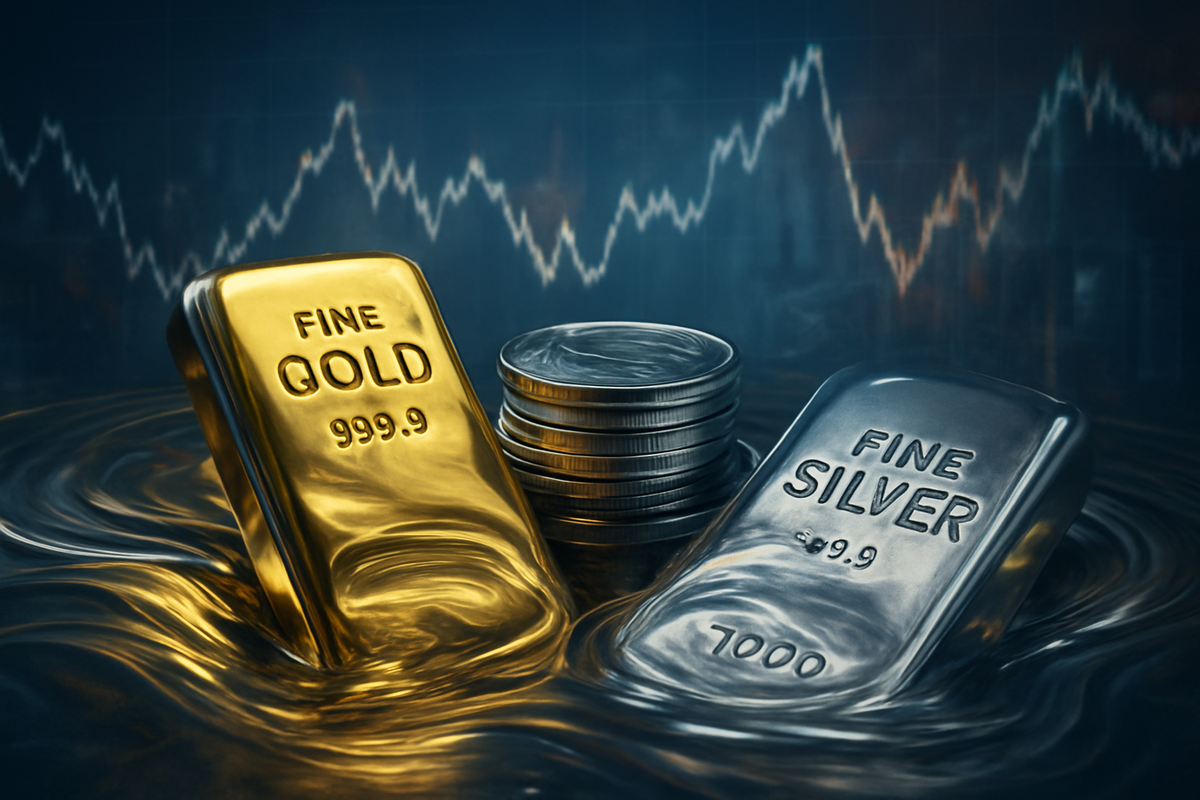
As of November 19, 2025, the precious metals market is undergoing a significant test, with gold and silver prices experiencing heightened volatility amidst shifting global economic tides. Both metals have recorded impressive gains throughout the year, driven by persistent inflation, geopolitical instability, and robust industrial demand for silver. However, recent pullbacks from all-time highs signal a period of consolidation, leaving investors to ponder the immediate and long-term implications for their portfolios. This dynamic environment underscores the enduring role of gold and silver as critical safe-haven assets and inflation hedges, even as they contend with interest rate uncertainties and a resilient U.S. dollar.
The current market reset is characterized by a complex interplay of macroeconomic factors. Gold, having surged approximately 55% year-to-date, recently eased from its all-time high of around $4,250 per ounce to trade in the $4,072-$4,084 range. Silver, a standout performer with a 74% year-to-date rally, also pulled back from its record high of $54.49 per ounce, now hovering around $50.70-$51.95. This volatility is a direct response to conflicting signals: strong underlying demand versus the Federal Reserve's hawkish stance on interest rates, which has dampened expectations for immediate rate cuts. Investors are keenly watching upcoming economic data and central bank communications to gauge the future direction of these vital commodities.
Detailed Coverage: A Market Under Pressure
The recent movements in gold and silver prices reflect a market grappling with a multitude of powerful forces. Gold's journey to its current levels has been fueled by a relentless pursuit of safety amidst global uncertainties. The metal's climb to an intraday peak of $4,250 per ounce, followed by a sharp over 3% decline, highlights the extreme sensitivity to market sentiment and news. This surge was initially propelled by persistent inflation across major economies, which has made gold an attractive hedge against currency debasement. Geopolitical flashpoints, including ongoing conflicts in Ukraine and the Middle East, coupled with broader trade disputes, have consistently driven safe-haven demand. Furthermore, a weakening U.S. dollar has historically made dollar-denominated assets like gold more appealing to international buyers.
Silver's trajectory has been even more dramatic, with its price rallying to an all-time high of $54.42 per troy ounce before a 4% decline. This exceptional performance is attributed not only to its safe-haven appeal but, crucially, to its burgeoning industrial demand. Silver is a critical component in green technologies such as solar panels, electric vehicles, and advanced electronics. The market has faced consistent supply deficits since 2021, a trend expected to continue into 2025 and 2026, creating a structural tailwind for prices. Key players influencing this market include global central banks, which continue to accumulate gold reserves as part of diversification and de-dollarization efforts, and the U.S. Federal Reserve, whose interest rate decisions are a primary determinant of short-term price movements. Initial market reactions have seen a "buy on dips" mentality emerge, with many analysts maintaining a long-term bullish outlook despite the current consolidation.
Corporate Fortunes: Who Wins and Who Loses?
The current environment of elevated and volatile precious metal prices creates distinct winners and losers among public companies and investment vehicles. Mining companies, in particular, stand to see significant shifts in their profitability and market valuations.
Potential Winners: Companies with strong production profiles, low operating costs, and diversified assets are best positioned to capitalize. Major gold producers like Newmont Corporation (NYSE: NEM, TSX: NGT) and Barrick Gold Corporation (NYSE: GOLD, TSX: ABX) are expected to benefit significantly from higher gold prices due to their scale and efficient operations. Agnico Eagle Mines Limited (NYSE: AEM, TSX: AEM) is also well-placed due to its operational consistency and focus on politically stable regions. For silver, Fresnillo plc (LSE: FRES), as the world's largest primary silver producer, is at the forefront of the rally, with its expansion plans set to boost annual output. Diversified producers like Pan American Silver Corp. (NASDAQ: PAAS) and focused players such as First Majestic Silver Corp. (NYSE: AG) are also poised for gains. Streaming companies like Wheaton Precious Metals Corp. (NYSE: WPM) offer a unique advantage, benefiting from rising metal prices without direct operational risks, securing future production at fixed, low costs. Investment vehicles such as physical gold and silver Exchange Traded Funds (ETFs) like SPDR Gold Trust (GLD) and Global X Silver Miners ETF (SIL) are direct beneficiaries, offering liquid exposure to the metals and the mining sector, respectively.
Potential Losers: Conversely, high-cost producers or companies with significant debt may struggle to fully leverage the bullish market, as their profit margins could be squeezed even with rising metal prices. Companies with operations concentrated in geopolitically unstable regions face increased risks of disruption, expropriation, or higher operating costs, which can negate the benefits of higher commodity prices. Furthermore, those with inadequate or overly aggressive hedging strategies might find their upside potential limited, causing them to underperform peers. While junior mining ETFs offer high potential, they also carry increased risk; a sharp market correction or failure in exploration projects by smaller companies could lead to steeper declines for these less resilient firms.
Wider Significance: Beyond Price Fluctuations
The current volatility in gold and silver prices extends far beyond mere market fluctuations, reflecting and influencing broader economic trends, regulatory landscapes, and historical patterns.
This environment of sustained interest in precious metals as safe havens underscores a fundamental lack of confidence in traditional financial instruments and fiat currencies amidst elevated inflation and geopolitical instability. It signals a broader reassessment of risk appetite, with investors seeking tangible assets to preserve wealth. The inter-market dynamics are evident: gold and silver prices typically exhibit an inverse relationship with the U.S. dollar, meaning a stronger dollar can exert downward pressure. Conversely, a weaker dollar enhances their appeal. Their appreciation during periods of monetary expansion and inflationary pressures, such as gold's 125.7% surge and silver's 116.3% rise between 2021 and November 2025, highlights their crucial role as diversification tools when traditional assets falter.
Regulatory and policy implications are also significant. Central bank monetary policies, particularly interest rate decisions by the U.S. Federal Reserve, remain primary drivers. The prospect of a "higher for longer" interest rate environment can make non-yielding assets less attractive, while anticipated rate cuts would provide support. Trade policies, such as potential U.S. tariffs, could further impact the dollar's strength and inflation, creating unique pricing dynamics. Notably, in November 2025, the U.S. officially classified silver as a "critical mineral," recognizing its strategic importance for national security. This designation could unlock increased government support and private investment in silver exploration and production, aligning with broader governmental efforts to enhance domestic mineral supplies. Historically, gold and silver have consistently acted as reliable stores of value during economic uncertainty and inflation, such as gold outperforming equities by 168% during the 2008 financial crisis. Silver's higher volatility compared to gold is also a historical norm, attributed to its smaller market size and significant industrial demand. The current trend of central banks diversifying reserves away from traditional assets echoes historical precedents where precious metals provided stability during times of crisis.
What Comes Next: Navigating the Future
The path forward for gold and silver prices involves a blend of short-term consolidation and a robust long-term bullish outlook, demanding strategic adaptation from investors.
In the short-term (next 3-6 months), both metals are expected to experience continued volatility. Gold is likely to consolidate around the $4,000-$4,100 range, with analysts suggesting a "buying on dips" strategy. Geopolitical tensions and persistent inflation will continue to provide underlying support, though uncertainty surrounding the Federal Reserve's interest rate decisions will introduce swings. Silver, currently in a consolidation phase around $46-$51, is also anticipated to recover from recent pullbacks, driven by strong industrial demand. A breakout above key resistance levels could trigger renewed momentum.
The long-term outlook (2026 and beyond) remains strongly bullish for both. Goldman Sachs projects gold to reach $4,900 per ounce by the end of 2026, with JPMorgan Chase & Co. anticipating it to surpass $4,000/oz by Q2 2026, citing recession risks, stagflation, and sustained demand. Some forecasts even project gold reaching $8,000-$9,800 by 2030. For silver, the long-term trajectory is even more aggressive, with projections ranging from $65 by 2026 to potentially $100 in 2029, and even exceeding $200 per ounce by 2030 under severe supply constraints and exponential green technology adoption. The "Industrial Super-Cycle" (2025–2027), fueled by silver's role in solar, EVs, and electronics, is a major long-term driver. Strategic pivots for investors include increasing portfolio allocation to precious metals (e.g., a "60/20/20" strategy), diversifying between physical and paper assets, and considering mining equities for leveraged exposure. Market opportunities abound in the form of continued inflation hedging, safe-haven demand, and the structural supply deficits for silver. Challenges include interest rate sensitivity, potential for broad market liquidation pressures, and supply chain disruptions. The most probable scenario involves short-term consolidation followed by a structural upside, with gold climbing towards $4,200 by early 2026 and silver consolidating around $40-$60 through 2028.
Comprehensive Wrap-Up: Enduring Value in Uncertain Times
The current financial landscape, characterized by significant market volatility and shifting economic tides, has unequivocally tested gold and silver prices. However, the overarching narrative remains one of enduring value and strategic importance for both precious metals. Key takeaways include their proven roles as hedges against persistent inflation and geopolitical instability, the robust and growing industrial demand for silver driven by green technologies, and the consistent accumulation of gold by global central banks.
Moving forward, the market for gold and silver is poised for continued growth, albeit with intermittent periods of consolidation and volatility. The structural demand drivers—inflationary pressures, safe-haven appeal, industrial consumption, and central bank diversification—are deeply entrenched and show no signs of abating. While interest rate policies from the Federal Reserve and the strength of the U.S. dollar will continue to influence short-term movements, the long-term outlook is firmly bullish for both metals.
The lasting impact of these trends underscores the necessity for investors to consider a strategic allocation to precious metals within a diversified portfolio. They offer a crucial counterweight to traditional assets during periods of stress, enhancing overall portfolio resilience. Investors should closely watch for upcoming U.S. economic data, particularly employment reports and inflation figures, as well as any shifts in central bank rhetoric regarding interest rates. Furthermore, monitoring geopolitical developments and the growth trajectory of green technologies will provide valuable insights into the future performance of these timeless assets.
This content is intended for informational purposes only and is not financial advice






